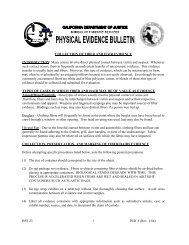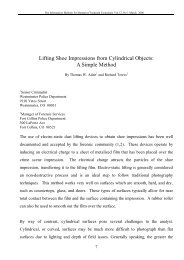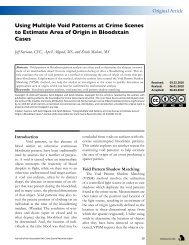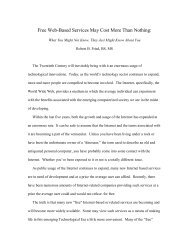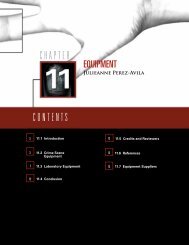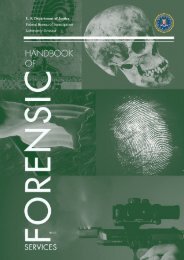PHYSICAL EVIDENCE MANUAL - Crime Scene Investigator Network
PHYSICAL EVIDENCE MANUAL - Crime Scene Investigator Network
PHYSICAL EVIDENCE MANUAL - Crime Scene Investigator Network
Create successful ePaper yourself
Turn your PDF publications into a flip-book with our unique Google optimized e-Paper software.
Physical Evidence Manual<br />
Major <strong>Crime</strong> <strong>Scene</strong> Duties/Responsibilities<br />
Protecting the <strong>Crime</strong> <strong>Scene</strong><br />
The first officer at the scene of a crime has several immediate responsibilities:<br />
• Ensure your safety and the safety of others.<br />
• Check the condition of the victim and render first aid if required.<br />
• Protect the scene to keep conditions as they were when you arrived.<br />
• Restrict sightseers.<br />
• Protect the evidence until it is collected.<br />
Team Leader Duties<br />
• Evaluate the scene and any safety concerns. No one should enter the<br />
crime scene without the proper safety and personal protective equipment.<br />
• Establish and define the boundaries of the crime scene using crime scene<br />
tape, ropes, barriers, etc. Start with expanded or enlarged boundaries;<br />
these may always be made smaller later in the investigation if they are<br />
determined to be too large.<br />
• Identify principal investigator(s).<br />
• Evaluate the legal authority for the crime scene search (e.g. scope of<br />
search warrant).<br />
• Perform a preliminary survey of the scene to evaluate potential evidence.<br />
• Provide a means of controlled entry and exit for personnel and equipment<br />
entering or leaving the scene. Look for shoe/tire impression evidence prior<br />
to establishing this route. 3<br />
• Give assignments to team members (e.g. evidence recorder/custodian,<br />
photographer, scene security, etc.).<br />
• Coordinate with other law enforcement agencies, District Attorney’s Office<br />
personnel, laboratory personnel, and others present at the scene.<br />
• Ensure sufficient supplies and equipment are available.<br />
• Continually reevaluate the requirements needed for a successful scene<br />
processing.<br />
Safety<br />
• The scene may be the source of contamination including blood and body<br />
fluids, tissue and human remains, chemicals, and explosive materials.<br />
• Individuals should not be permitted to eat, drink, smoke, or apply makeup<br />
at the scene.<br />
• Be on the alert for sharp objects such as hypodermic needles, razors,<br />
3 See “Footwear and Tire Tread Evidence – Two-Dimensional Impressions/Prints.”<br />
Adopted: May 2002<br />
Revisions: 6<br />
Last Revision: January 31, 2008<br />
8-2



